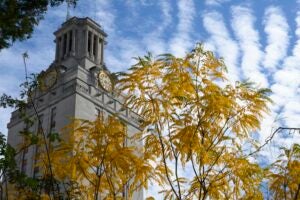
At The University of Texas at Austin, research is an essential part of our DNA. (Coincidentally, DNA is an essential part of our research.) UT is one of the most highly rated public research universities in the nation.
But research isn’t exclusively within the purview of faculty and graduate students. Undergraduates can start as early as freshman year, supported by programs like student-run research journals, the EUREKA Research Database and the Freshman Research Initiative, the nation’s largest effort to involve first-year students in meaningful research, placing them in faculty-led laboratories working on real-world research projects.
Need more proof? Just take a look at this impressive list of undergraduate research poster presentations made at this year’s Research Week, UT’s annual celebration of undergraduate research and creative activity. (For the full list, go here.)
Science
Analyzing and predicting shoreline change rates along the Aransas National Wildlife Refuge
Preston McLaughlin, geography
Bayesian modeling of neuron firing rate maps using a B-spline prior
Eszter Kish, neuroscience; Eric Rincon, computer science
Biological filtration of contaminants from drinking water
Ethan Howley
Building personality
Computational sequencing and humanization of antibodies
Coral Loockerman, biology
Identifying a novel inhibitor for GES-5 Carbapenemase in Klebsiella pneumonia infections by virtual drug screening
Xenia Gonzalez, biology
Searching for high redshift (z=8) galaxies using the Brightest of Reionizing Galaxies survey (BoRG)
James Diekmann, astronomy
The Herschel Space Telescope confirms the decay of supersonic turbulence
Rebecca Larson, astronomy, physics
Transcriptional control of the Manganese Efflux Transporter, SLC30A10
Jonathan Mercado, biology
Arts and Humanities

Artistic freedom: What is the boundary between freedom of speech and the public good?
Crystal Schreiber, visual art studies; Yeun Jae Chang, visual art studies; Minhye Choi, studio art; Gregory Castillo, visual art studies
College athletics: Athletes first, students second?
Daniel Escobar, philosophy
Fakers of aboriginal art
Ashley Stanford, art history
From the bones of wolves: Guitar music from the southwest United States
Thales Smith, music performance, plan II
Meaning in public space: The Texas State Capitol as epideictic rhetoric
David DeVine, rhetoric and writing
Mistakes were made: On the use of agency and other factors in the analysis of political apology speeches
Alina Carnahan, rhetoric and writing
No crusades, no Columbus: A study of cultural interchange 1100–1500
Jeremy Wenzel, computer science
Rehabilitating canines: The journey of former fighting dogs
Larissa Zelezniak, history
The media and crime: What is real and what is perceived?
Michelle Jackson, psychology
Unfeminist coalition in Game of Thrones
Choyette Mahtab, anthropology
Social Sciences

Gender beliefs and mental health outcomes among Mexican Americans in borderland communities
Maria Renteria, social work, anthropology
Evolving obesity prevention policies in United States elementary schools: 1966–2014
Stephanie Astle, nursing
Investing foul play in financial crisis: An introduction to forensic finance
Kevin Mei, economics, finance
Online activism and networked feminism: Wendy Davis and her filibuster
Ketty Loo, psychology
Prevention of substance use with military veterans in college: Beliefs system and psychological distress
Christine Rodriguez, social work
Testing global colorectal cancer incidence in developing countries using risk factor data
Austin Porter, plan II
The development of auditory category learning: A computational modeling approach
Nicole Tsao, communication sciences and disorders
The effect of candidate race on federal campaign contributions
David Singer, government
The missing piece: Music in geriatric health
Alice Jean, environmental science
The war on coal: A case study in agenda setting
Hannah Johnson, geological sciences, government
Understanding speech patterns in young children with hearing impairments
Samantha Moses, John Torres (both communication sciences and disorders)



